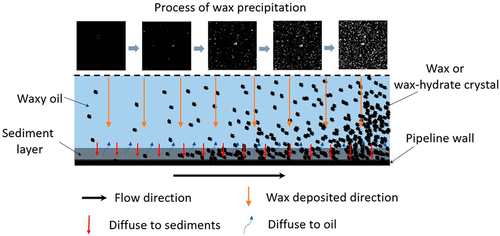当前位置:
X-MOL 学术
›
Energy Fuels
›
论文详情
Our official English website, www.x-mol.net, welcomes your feedback! (Note: you will need to create a separate account there.)
Wax and Wax–Hydrate Deposition Characteristics in Single-, Two-, and Three-Phase Pipelines: A Review
Energy & Fuels ( IF 5.2 ) Pub Date : 2020-10-14 , DOI: 10.1021/acs.energyfuels.0c02749 Zhiming Liu 1, 2 , Yuxing Li 1, 2 , Wuchang Wang 1, 2 , Guangchun Song 1, 2 , Zhiyuan Lu 3 , Yuanxing Ning 1, 2
Energy & Fuels ( IF 5.2 ) Pub Date : 2020-10-14 , DOI: 10.1021/acs.energyfuels.0c02749 Zhiming Liu 1, 2 , Yuxing Li 1, 2 , Wuchang Wang 1, 2 , Guangchun Song 1, 2 , Zhiyuan Lu 3 , Yuanxing Ning 1, 2
Affiliation

|
In the oil pipeline transportation system, wax deposition will reduce the effective circulation area, weaken the overall pipeline transportation capacity, and even block the pipeline, which seriously threatens the safety of the pipeline flows. In the actual production of oil fields and the transportation of oil products, except for the single-phase waxy crude oil, under most conditions, operations are performed using multiphase mixed transportation, so it is necessary to determine the wax deposition characteristics in those pipeline systems. In this Review, three new wax deposition mechanisms proposed in recent years and several typical experimental devices were summarized, the wax deposition in oil–water and oil–gas flow systems and the wax–hydrate coupling deposition in oil–gas–water flow system flows were concluded; the mathematical models were also categorized based on the three flow systems. Meanwhile, it highlighted the fact that, in the two-phase flow, because of the complexity of the flow pattern and the presence of the second interface on the wax deposition process, independent theoretical research on the mechanism of wax deposition is particularly necessary; based on this, a more-accurate wax deposition prediction model can also be developed. For the coupled deposition of wax-hydrate in the three-phase flow system, experimental instruments such as FBRM, PVM and molecular dynamics simulations could be used to study the distribution characteristics and interaction rules of wax crystals and hydrate particles from a microscopic perspective. On the other hand, the mechanism of wax crystal and hydrate coupling deposition by additives such as antiwax agents, hydrate inhibitors, antipolymerization agents, and pipeline transportation conditions can be investigated experimentally to better control the deposition process during pipeline operation and ensure the safe flow in the transportation system.
中文翻译:

单相,两相和三相管道中的蜡和蜡水合物沉积特性:综述
在输油管道运输系统中,蜡的沉积会减少有效的流通面积,削弱输油管道的整体运输能力,甚至堵塞输油管道,严重威胁输油管道的安全。在油田的实际生产和石油产品的运输中,除了单相蜡质原油外,在大多数情况下,操作都是使用多相混合运输进行的,因此有必要确定那些管道系统中的蜡沉积特性。 。在这篇综述中,总结了近年来提出的三种新的蜡沉积机理和几种典型的实验装置,在油气水和油气流动系统中的蜡沉积以及在油气水流动系统中的蜡水合物耦合沉积。得出结论;数学模型也基于这三种流动系统进行了分类。同时,它强调了这样一个事实:在两相流中,由于流型的复杂性和蜡沉积过程中第二界面的存在,特别需要对蜡沉积机理进行独立的理论研究。基于此,还可以开发更准确的蜡沉积预测模型。为了使蜡水合物在三相流系统中耦合沉积,可以使用FBRM,PVM和分子动力学模拟等实验仪器从微观角度研究蜡晶体和水合物颗粒的分布特征和相互作用规律。另一方面,蜡结晶和水合物通过添加剂(例如抗蜡剂,
更新日期:2020-11-19
中文翻译:

单相,两相和三相管道中的蜡和蜡水合物沉积特性:综述
在输油管道运输系统中,蜡的沉积会减少有效的流通面积,削弱输油管道的整体运输能力,甚至堵塞输油管道,严重威胁输油管道的安全。在油田的实际生产和石油产品的运输中,除了单相蜡质原油外,在大多数情况下,操作都是使用多相混合运输进行的,因此有必要确定那些管道系统中的蜡沉积特性。 。在这篇综述中,总结了近年来提出的三种新的蜡沉积机理和几种典型的实验装置,在油气水和油气流动系统中的蜡沉积以及在油气水流动系统中的蜡水合物耦合沉积。得出结论;数学模型也基于这三种流动系统进行了分类。同时,它强调了这样一个事实:在两相流中,由于流型的复杂性和蜡沉积过程中第二界面的存在,特别需要对蜡沉积机理进行独立的理论研究。基于此,还可以开发更准确的蜡沉积预测模型。为了使蜡水合物在三相流系统中耦合沉积,可以使用FBRM,PVM和分子动力学模拟等实验仪器从微观角度研究蜡晶体和水合物颗粒的分布特征和相互作用规律。另一方面,蜡结晶和水合物通过添加剂(例如抗蜡剂,







































 京公网安备 11010802027423号
京公网安备 11010802027423号